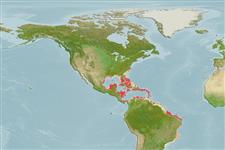>
Holocentriformes (Squirrelfishes, soldierfishes) >
Holocentridae (Squirrelfishes, soldierfishes) > Holocentrinae
Etymology: Holocentrus: Greek, holos = full + Greek, kentron = sting (Ref. 45335).
More on author: Walbaum.
Environment: milieu / climate zone / Tiefenbereich / distribution range
Ökologie
seewasser riff-verbunden; tiefenbereich 0 - 32 m (Ref. 3724). Tropical; 36°N - 28°S, 98°W - 31°W
Western Atlantic: Bermuda and southern Florida, USA to northern South America and Brazil; throughout the West Indies (Ref. 3724). Antilles, northwestern Gulf of Mexico, Yucatan to Colombia (Ref. 26938).
Length at first maturity / Size / Gewicht / Alter
Geschlechtsreife: Lm 13.5 range ? - ? cm
Max length : 35.0 cm TL Männchen/unbestimmt; (Ref. 5217); common length : 25.0 cm TL Männchen/unbestimmt; (Ref. 5217)
Rückenflossenstacheln (insgesamt) : 11; Rückenflossenweichstrahlen (insgesamt) : 14 - 16; Afterflossenstacheln: 4; Afterflossenweichstrahlen: 9 - 11. Conspicuous white spot behind tip of each dorsal spine (Ref. 26938). Body slender. Upper jaw extending posteriorly to middle of pupil (Ref. 37108). Body bright red or red striped, sometimes blotched (Ref. 7251). Similar in color to H. ascensionis, but each interspinous membrane of dorsal fin with a white spot near margin (Ref. 13442).
Body shape (shape guide): fusiform / normal.
Nocturnal (Ref. 37108), inhabits clear reefs (Ref. 5217). Found near mouths of caves and holes (Ref. 26938); at night they usually move to sandy areas and grass beds to feed on crabs, shrimps, gastropods and brittle stars (Ref. 3724). Marketed fresh but not popular as a food fish (Ref. 5217).
Robins, C.R. and G.C. Ray, 1986. A field guide to Atlantic coast fishes of North America. Houghton Mifflin Company, Boston, U.S.A. 354 p. (Ref. 7251)
IUCN Rote Liste Status (Ref. 130435: Version 2025-1)
Bedrohung für Menschen
Reports of ciguatera poisoning (Ref. 30303)
Nutzung durch Menschen
Fischereien: weniger kommerziell; Aquarium: Kommerziell
Tools
Zusatzinformationen
Download XML
Internet Quellen
Estimates based on models
Preferred temperature (Ref.
123201): 23.9 - 28.1, mean 27.3 °C (based on 817 cells).
Phylogenetic diversity index (Ref.
82804): PD
50 = 0.7500 [Uniqueness, from 0.5 = low to 2.0 = high].
Bayesian length-weight: a=0.01175 (0.00706 - 0.01957), b=2.88 (2.74 - 3.02), in cm total length, based on LWR estimates for this species & (Sub)family-body (Ref.
93245).
Trophic level (Ref.
69278): 3.5 ±0.4 se; based on diet studies.
Generation time: 1.2 ( na - na) years. Estimated as median ln(3)/K based on 1
growth studies.
Widerstandsfähigkeit (Ref.
120179): hoch, Verdopplung der Population dauert weniger als 15 Monate. (K=0.9).
Fishing Vulnerability (Ref.
59153): Low vulnerability (19 of 100).
🛈
Nutrients (Ref.
124155): Calcium = 60 [28, 192] mg/100g; Iron = 0.729 [0.304, 1.443] mg/100g; Protein = 18.8 [17.6, 19.9] %; Omega3 = 0.149 [0.062, 0.348] g/100g; Selenium = 37.2 [22.2, 66.9] μg/100g; VitaminA = 49.5 [19.4, 131.3] μg/100g; Zinc = 1.26 [0.82, 1.95] mg/100g (wet weight);
